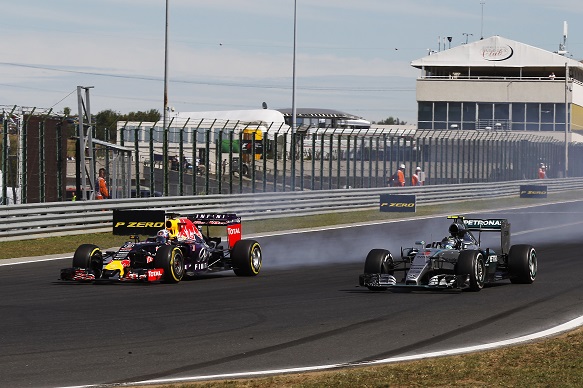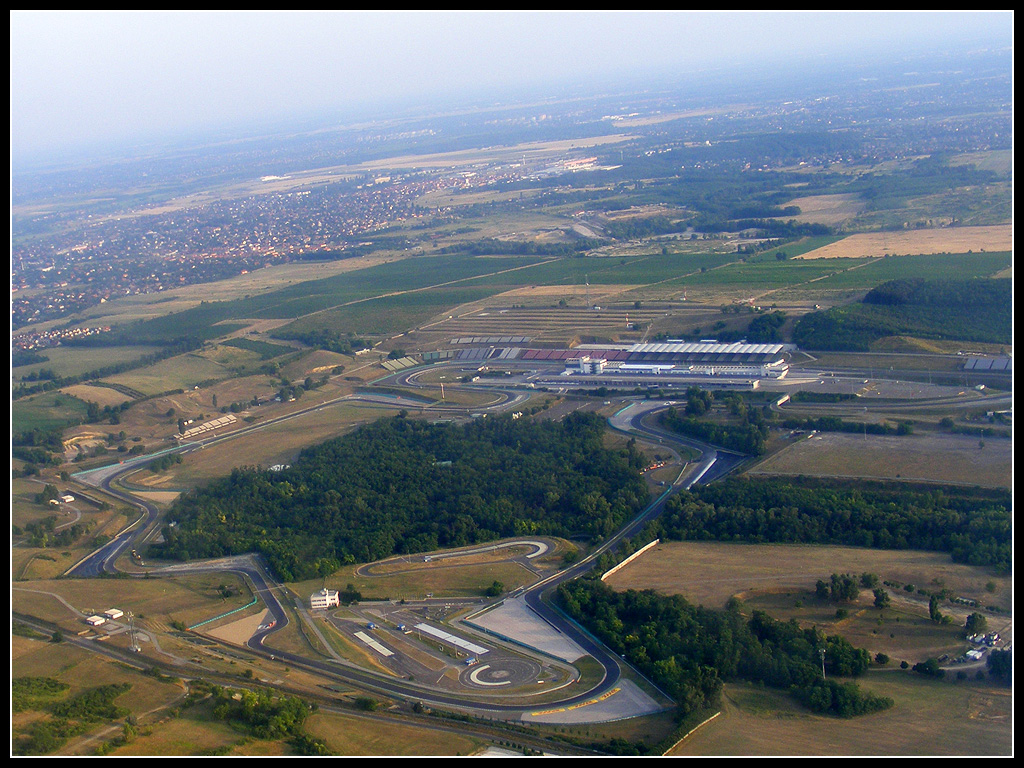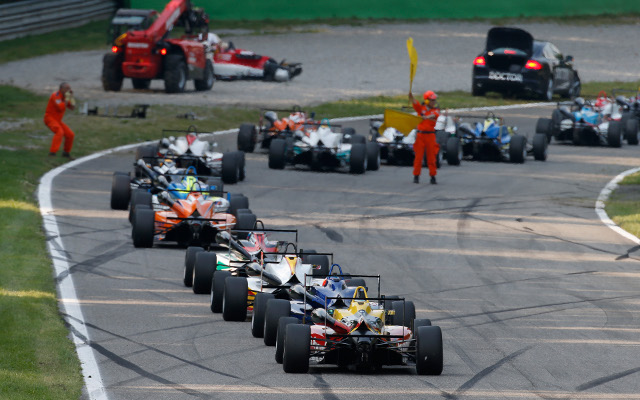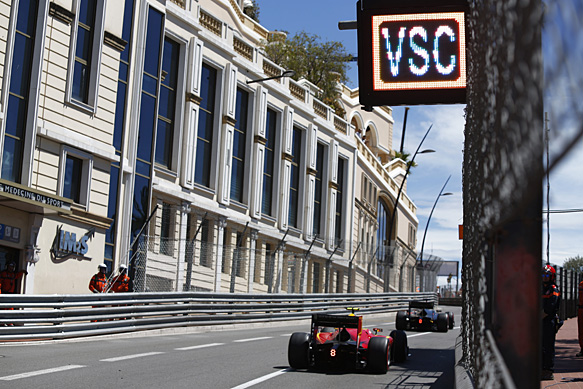Every year we come to the Hungarian GP and we reflect on it's reputation for dull, processional races - only the intervention rain has breathed life into the event. Today was a whole different kettle of Piranhas - it was magnificent, dynamic and it was everything that the naysayers were complaining that F1 wasn't. The dominance has finally been toppled, and today was another example that once things do start to go slightly awry for the Mercedes team, the wheels just fall off the wagon good judgement is replaced by desperation and inaccuracy. It was a race full of incident, penalties, surprises, more penalties, a safety car, and some more penalties - most of which were handed to Maldonado for another errant day. F1 has seen some really dull and tiresome events this season, but this was certainly not one of them and was easily the highlight of the year, and will take some beating.
On another and slightly unrelated note, there was no real qualifying report - because I was spending the day dressed as the Ice King/Simon Petrikov at a local convention. Which was an utterly surreal and entertaining day, mostly because the majority of the day involved struggling to see through the glasses and putting the nose back on. I took pictures and signed things - which is far more than I figured that costumer design deserved. So as a result, I was a little to busy and tired to put together a post having worked through the coverage I recorded.
The Race
Everyone, including myself anticipated a default Mercedes 1-2 where the two silver cars vanished off into the distance and everyone else just fell into position behind them. But that wasn't quite going to happen - even the start didn't materialise quite the way it was supposed to go, because the first attempt at the start was aborted as Felipe Massa missed his grid slot. On the second time of asking the start went ahead as planned - and off the line it was Sebastian Vettel from third place making an initial jump to the front as both Mercedes struggled. Raikkonen followed Sebastian through into second place, and on top of that Rosberg was able to take third place from Hamilton. So an initial pole position was converted into 4th place at the end of the first corner. On the exit of turn one Ricciardo and Bottas had a minor coming together which bounced the Red Bull into the air - fortunately Daniel lived to be rammed again later in the race. Further round the lap, Hamilton tried to take third from his team-mate with a daft and overly optimistic move at the chicane. Lewis ended up on the outside and had to cut across the gravel - pole position new became 10th place after the opening lap... which had all the ingredients of an interesting afternoon.
A Mercedes 1-2 had been converted into a Ferrari 1-2 all expectations and preconceptions were firmly out of the window. To make matters more. surprising, both the Ferraris were pulling away from the Mercedes of Nico Rosberg in third - where had this pace come from, and can we have some more of that for the rest of the season to spice the championship up. Elsewhere the first of the day's many, many penalties started rolling in - this one was a 5-second pit penalty for Massa because of his start position error. But for now Massa was far more interested in the attentions of Lewis Hamilton - of all the cars Lewis could find himself trapped behind it was a Mercedes powered Williams with a competitive straight line speed. After a couple of laps struggling to make it past the Brazilian, Lewis went round the outside of Felipe in turn one - brushing wheels on the exit of the corner. Yet our attention was turned away from Hamilton's recovery drive to Daniil Kvyat's team radio as the Russian was complaining of a tyre vibration due to a flatspot. But because of the vibration Daniil sounded like a Dalek over the radio, alas Mr Death Stare didn't mention exterminating anyone and anything... which was a shame.
Having announced his allegiance to the Dalek empire, Kvyat was under pressure from his team to 'not hold up' Ricciardo, which in team order terms is a subtle reminder to get out of the way. Daniil Kvyat protested over the radio - about the decision but eventually he relented and allowed the Australian through on the straight before turn four. Hamilton on the other hand was continuing his recovery through the field - firstly making an easy DRS pass on the Force India of Sergio Perez. He then started to gain more positions as the pit stops started with Kvyat and Bottas among the early visitors to pit-lane. But it was this round of stops which saw another entry in the penalty book, this time it was Romain Grosjean who felt the force of the Stewards as he was penalised for an unsafe release as he was released into the path of Massa's Williams after Felipe was held in his pit-box for his 5-second penalty.
That Ferrari lock-out started to show some signs of weakness - because Raikkonen reported a loss of power and a strange sound in the cockpit. The team reported that there was a developing issue with the MGU-K but it shouldn't prevent the car from running. But further back there was another car failure that proved to be a little more terminal. As Nico Hulkenberg was powering down the main straight, the front wing just dropped off the car and fell under the front wheels - exploding into a cloud of carbon fibre shrapnel. Shrapnel that Kvyat had to drive through as it decorated the pit-straight. Hulkenberg's car continued down the run-off area and into the tyre barrier at the bottom of the turn one run-off area having lost all front downforce and locking both wheels. Initially a
virtual safety car was deployed to handle the retrieval of Nico's car, but on noting the volume of debris on the straight a full safety car was deployed to help the clean-up operation. This was a good time for the teams to pull their cars in for a new set of tyres, setting up the second half of the race to be a brilliant showdown. Things had been quite fun thus far, but they were about to be taken up a notch.
On the restart Rosberg took second place from Raikkonen, whose power problems made him defenceless to the Mercedes. Further back Ricciardo pounced on Hamilton, as Lewis defended to the inside Daniel out-braked him on the outside and swept in front of the Briton. But Hamilton locked a front wheel and slid straight into the side of the Red Bull - damaging his front wing, and taking some of Ricciardo's sidepod off in the process. With a damaged car Hamilton struggled round the rest of the lap, letting Ricciardo through in turn two. By the time he reached turn three a queue began to form headed by Kvyat and Bottas - in turn four he ran out wide taking Daniil with him and the Russian got alongside Lewis while the pair were both driving in the run-off area. At the same time Bottas and Verstappen were staying on the track in an effort to take advantage of the situation. Bottas was edged wide as both Kvyat and Hamilton rejoined the circuit opening half an opportunity for Verstappen who tried to put the car up the inside of Valtteri's Williams making contact with his rear tyre. This punctured Bottas' left rear and trimmed yet more winglets were cast into the run-off area. This meant that both Williams were now in for a difficult race. Yet another stewards investigation was called to handle Hamilton's latest escapade, and they decided that he too deserved a drive through penalty which added to the fact he also had to pit for a new front wing.
Raikkonen was continuing to struggle with his Ferrari - being informed that the MGU-K had completely failed - but there was another cause for concern as he reported some front wing damage as he noticed some carbon fibre falling off the car. An external camera shot revealed that is was the camera pod from the side of the nosecone that had parted company rather than any element from his front wing. The Finn brought the car into the pit-lane for a full manual reset - switching off the car and restarting it via the external starter motor. Raikkonen rejoined the track but the issue wasn't resolved and Ferrari were forced to retire the car. Speaking of people having an unfortunate day - we have the curious case of Pastor Maldonado, he must have grown jealous of the number of other drivers picking up penalties so he decided to up his personal tally. First he was handed a second drive through penalty for speeding in the pit-lane, and at the same time he was under investigation for overtaking under the safety car. Also joining the list of penalised drivers was Max Verstappen - for speeding under the safety car and Daniil Kvyat for gaining an advantage by leaving the track. At this point in time I had to check whether I had received a time penalty, because everyone else was getting one. The upside of all this was that we now had two McLarens inside the points...
Back at the front Vettel headed a trio of cars in with a shout of taking the victory including Nico Rosberg and Daniel Ricciardo. For a time it looked like Sebastian's lead was under threat as Rosberg had the quicker car, but for some reason Mercedes put the German onto the harder, slower compound. While Vettel and Ricciardo were on the soft tyres, and Ricciardo had a pace advantage over both cars. Daniel had disadvantage of a Renault engine and therefore couldn't get anywhere close enough in a straight line, even with the provision of
DRS. But we have seen that Ricciardo doesn't mind a late braking manoeuvre or two, and this one was taking that idea to the extreme. Ricciardo threw the car at the inside of Rosberg from an absurd distance - brakes locked and skating wide of the apex. Rosberg cut back to the inside and moved across to the outside of the track on the exit. But he wasn't completely clear of Ricciardo's nose, and clipped his front wing, causing a rear tyre puncture on Rosberg's car. Both drivers had to limp back to the pits for repairs, but Rosberg's inlap was considerably slower considering he only had three wheels in contact with the ground. Nico was only five laps away from entering the winter break with a championship lead - and now he was behind Hamilton on track and even further behind in the championship. Hamilton of course was scything past cars because he was on new, soft tyres and racing against slower cars on older rubber.
This altercation left Vettel all by himself out in front, and promoted Daniil Kvyat up into second place, while Ricciardo's wing change dropped him down to third - while Rosberg was now down in 8th. So Sebastian took the win, a deserved one for Ferrari and a poignant one in a weekend that celebrated the life of Jules Bianchi - a driver tipped to be Vettel's future team-mate. Kvyat crossed the line in a momentous second place - ahead of Ricciardo who had a chaotic race with multiple collisions. Outside the podium was Max Verstappen, almost anonymously claiming 4th place - which is another magnificent achievement for the teenager - even with picking up a penalty along the way, but those were commonplace today. In 5th place was another remarkable result - Fernando Alonso taking home a large points haul for McLaren and by far their best finish of the season. Alonso crossed the line ahead of Hamilton who by his own admission had a bit of a crap day. In seventh place was Romain Grosjean, who for some reason ended up with the same number of licence penalty points as his team-mate who racked up more on-track penalties. So while the stewards picked up their game, the FIA were a long way behind today. The points were rounded off by Rosberg in 8th, Jenson Button completing a double points score in 9th and Marcus Ericsson picking up the last point. It is odd that despite making more errors and earning penalties - Lewis still finished ahead of Rosberg, and today was the first race in the new turbo-hybrid era in which a Mercedes hasn't finished on the podium...
The Bonus Points Championship Points Winners - Qualifying
Because there wasn't a report following qualifying, there wasn't any points allocated, so to keep the championship fair, these points will be outlined today. Not that I can really remember too much about yesterday other than being painted blue and carrying a penguin.
- 10pts - Daniel Ricciardo - Almost got the Red Bull ahead of both Ferraris and brought Red Bull back towards the front.
- 8pts - Mad Max Verstappen - The only Toro Rosso to make it into Q3
- 6pts - Lewis Hamilton - An utterly dominant pole position deserves some points
- 5pts - Bottas/Grosjean - Share some points for some brilliant sideways action, Grosjean in turn five and Bottas out of the final corner
- 4pts - Goku - Seems like an odd selection for some points - a fictional character - but I spent Saturday in the company of many fictional characters and Goku gets points for the company and the provision of tea
- 3pts - The Skyrim Elves - Two brilliant costumes - held together by the ultimate binding force of duct tape.
- 2pts - Fernando Alonso - Dragged the McLaren out of the relegation zone and into Q2
- 1pt - Roberto Merhi - Comes back from a violent accident in formula renault 3.5 - which was pretty much all his own fault - to out-qualify Stevens
- 5pts - Sergio Perez - An additional brace of points is handed to Sergio Perez for his flip in FP1 - a graceful roll but didn't complete a full 360 degrees
The Bonus Points Championship Points Winners - The Race
Moving swiftly on to the events of today, and where do I even begin - so many drivers doing wondrous things, and so many drivers doing daft and ridiculous things. Where do I even begin...
- 25pts - Daniel Ricciardo - After being assaulted by both Mercedes and Valtteri Bottas he still made the podium in an unfavoured car.
- 18pts - Daniil Kvyat - Gets points for his first ever podium and for sounding like a Dalek on the radio
- 15pts - Fernando Alonso - Normally 5th place in a McLaren would be a bad day, but in this season's car it is a miracle and a really good job
- 12pts - Mad Max Verstappen - Fourth place is his highest ever finish in his short career - but kept the car in one peice... mostly unlike others.
- 10pts - Vettel/Raikkonen - A brilliant opening lap for both Ferrari drivers and it would have been a 1-2 finish had reliability claimed Raikkonen.
- 8pts - Nico Hulkenberg - Rocketed off the line and made the most progress of anyone on the opening lap
- 6pts - Jenson Button - Completed a double points scoring finish for McLaren and their first this season.
- 4pts - Lewis Hamilton - Made an idiot of himself on several occasions but delivered strong recovery drives in both instances
- 2pts - Pastor Maldonado - I shouldn't commend his day, but it was funny and I enjoyed the laugh
- 1pt - Marcus Ericsson - Salvaged a solitary point for Sauber in tenth place
- -1pt - Lewis Hamilton - Didn't have a good day today did you now - and started proceedings by instantly blaming Rosberg for his own mistake.
- -1pt - FIA Penalty Points System - In a race where so many penalties were dished out, the penalty points system is proving to be inadequate and woefully executed. Grosjean got the same number of penalty points for an unsafe release, that Maldonado did for a spate of incidents.
- -1pt - Moiracon Judging Panel - Why no prizes for the Ice King, why - Gunther disapproves of your actions
Looking ahead to Spa
The summer break starts now, even though we soft of already had a summer break due to the cancellation of the German GP, but this one separates us from the majesty that is the Belgian GP. The recent Spa 24hr race was a run under incredibly changeable conditions, including what appeared to be a mini-monsoon. All descending on one of the few remaining fearsome and challenging venues left on the calendar - and it is that challenge that awaits the grid after the holiday period. Traditionally we wrap up proceedings from the Hungarian GP and look to Belgium to provide what Budapest failed to deliver, but this time the Hungarian GP was spectacular and didn't even need the intervention of the weather. So we can only ask Spa to try and deliver something even more spectacular, and even if it falls slightly short - it will still be a special race.





















